On the map at right, the blue line approximates the French line. The letters on the map correspond to the panoramas below.

|
The French Army of the Rhine under Marshal Bazaine was intercepted on
August 16th at Mars-la-Tour
as it withdrew from Metz toward Verdun.
Forgoing a continuation of the battle the next day or an attempt
to escape by a more northerly route, Bazaine fell back toward Metz to
refit
his army for another fight. He positioned his army of 112,000 men
along a roughly eight mile line from behind Mance Ravine on his
southern flank, then through Amanvillers in the center to St. Privat
and Roncourt on the right flank. The French entrenched in a
naturally strong position and awaited an attack. The Prussians
and their German
allies, all under Helmuth von Moltke, brought up an additional army,
the First, and followed the French east and north to their new
defensive line, eager to cut off any remaining escape route from Metz.
Moltke had 188,000 men available, and King Wilhelm was in
attendance. On the map at right, the blue line approximates the French line. The letters on the map correspond to the panoramas below. |
 |


| After the withdrawal of Manstein's line of artillery, German infantry began to appear. The Bois des Genivaux and the Bois de la Cusse were occupied. Here there are monuments to the 3rd Guards Brigade which reinforced the IX Corps at around 2pm and fought the French 4th Corps in Amanvillers and the 3rd Corps south of here. The French line centered on Amanvillers and extended through the Montigny farm to the south. The French position here would hold until later in the battle. To the south, the Germans were facing an even stronger French position. | 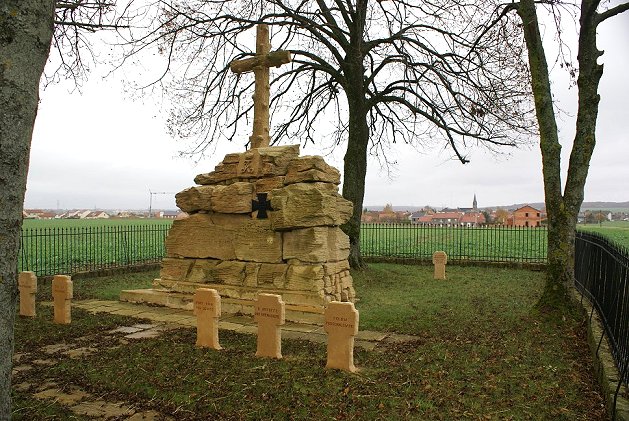 |
 |





| St Hubert Farm was just beyond the Mance Ravine. Surrounded by
stone walls, the farm was a formidable strong point. With the help of
the German artillery brought to the edge of Mance Ravine, the farm was
smashed and half of the 750 man garrison was put out of action. The
remainder fell back as the farm was then captured by Germans of the
28th and
67th Regiments at around 3:30pm. By 4pm, the fighting here died down.
A mass grave exists just off the panorama to
the left. (See photo at right.) Beyond the mass grave is the Metz to Verdun Road. On the right of the
panorama is Moscou Farm, defended by
Lebeouf's III Corps. |
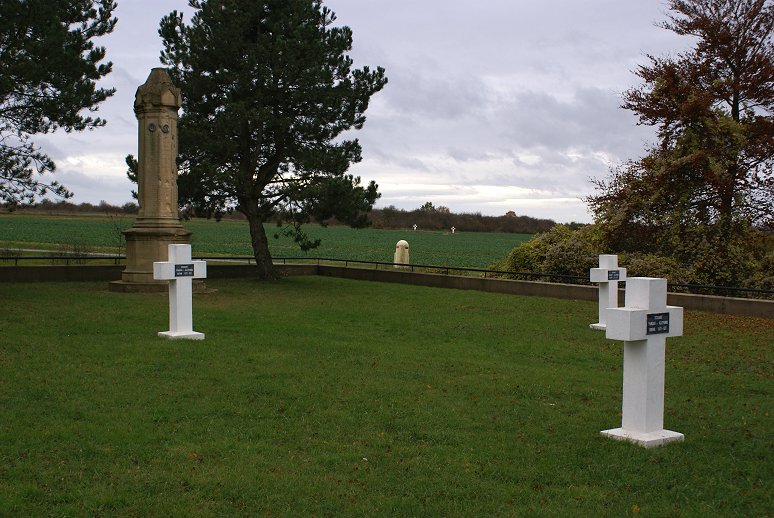 |





| The Second Army under Frederick Charles had blundered toward
Amanvillers thinking that it was the French center. This induced
Steinmetz to order his First Army to attack. Meanwhile, Frederick
Charles sent 30,000 Guard infantry, plus cavalry and 90 guns and the
20,000 man XII Corps sweeping north to not only protect the flank of Manstein's
IX Corps, but also to move around the French right flank. Two and
a half French battalions (1,500 men) and an artillery battery defended
Ste Marie-aux-Chenes in front of St Privat, but this force only
held off the Germans for an hour, and its abandonment at 3:30pm allowed the Germans to turn the French position.
The French 6th Corps under Canrobert had made St Privat into a
fortified position with a good, open field of fire. But 6th Corps was
without cavalry and mitrailleuses - and was also short on artillery. His
right flank was also vulnerable. Canrobert informed Bazaine of the
danger but got no reinforcements. By 4pm, German artillery was bombarding the French position north and south of St Privat. The Saxons on the far left were not yet in position, but Frederick Charles ordered an attack by the Prussian Guards regardless. Starting at around 4:45pm, 18,000 Prussian Guards began an attack. The Guards lost over 8,000 men in the course of an hour in their failed frontal attack on St. Privat. It was one of the great attacks in military history - sometimes compared with Pickett's Charge and the French Imperial Guard at Waterloo. As in other locations that day, the French did not capitalize on German failure by launching a counterattack. With the failure of the Guards attack, German hopes sank, but there was one German corps left to enter the battle, the Saxon XII Corps on the far left. |
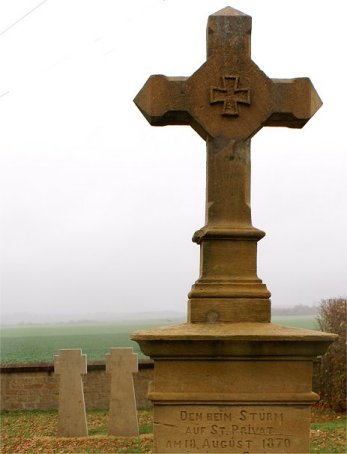 |
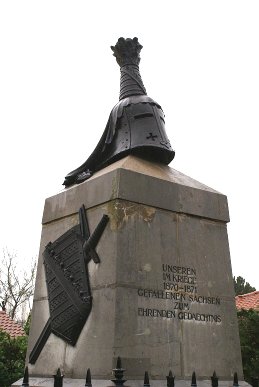 Saxon Monument at St. Privat Saxon Monument at St. Privat |

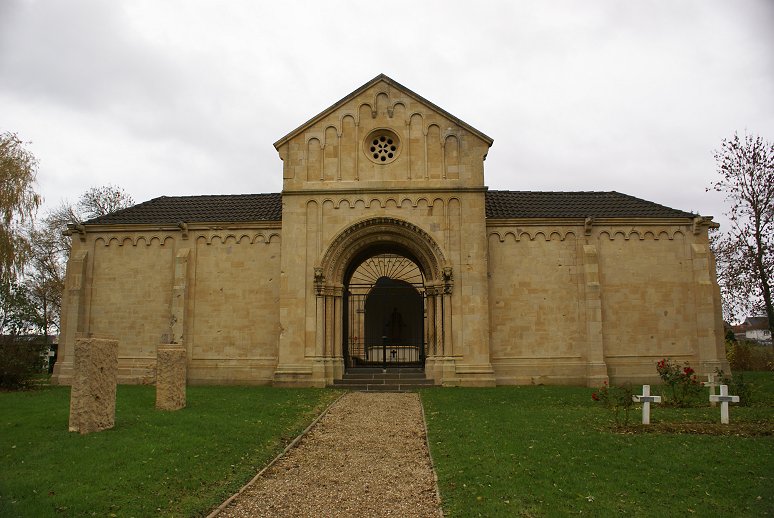 |
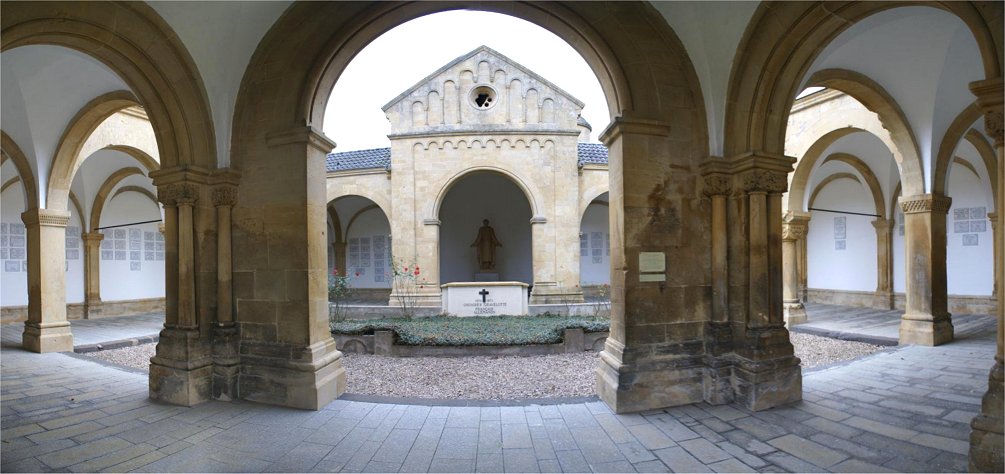 |
| C) Gravelotte Military Cemetery Bazaine's army remained in Metz, besieged by a German army until they surrendered in the fall. The German victories at Mars-la-Tour and Gravelotte-St. Privat, a brilliant one followed by an ugly one, lead ultimately to Prussian victory in the war. Napoleon III organized a new army to relieve Metz, but Moltke outmaneuvered him and forced him to surrender at Sedan. The war continued into early 1871, resulting in German unification under Prussian leadership and the fall of the French Empire and birth of a republic. German annexation of the ethnically German French territories - would help spark the First World War, which, in turn, would spark the Second. Perhaps appropriately many of the monuments at Gravelotte-St. Privat and Mars-la-Tour show damage from the Second World War, specifically from Patton's 1944 battle of Metz. |
  |